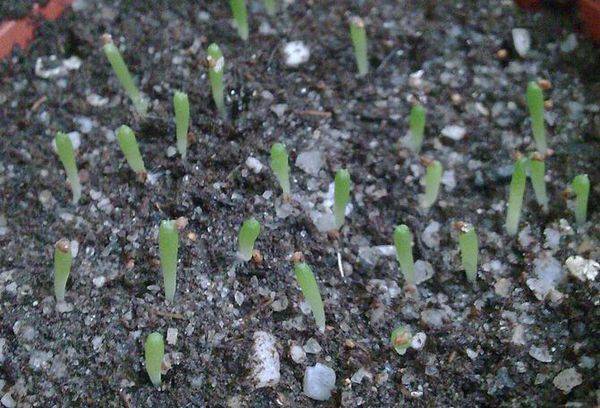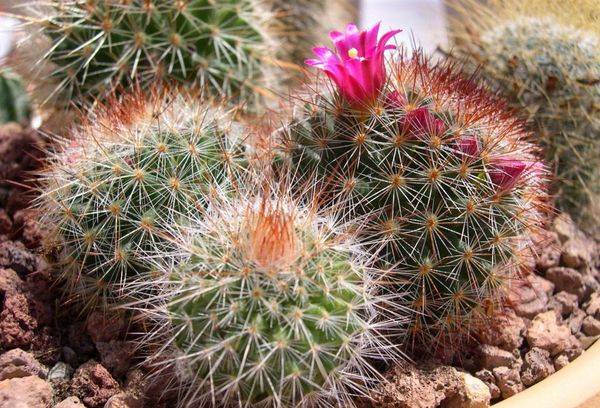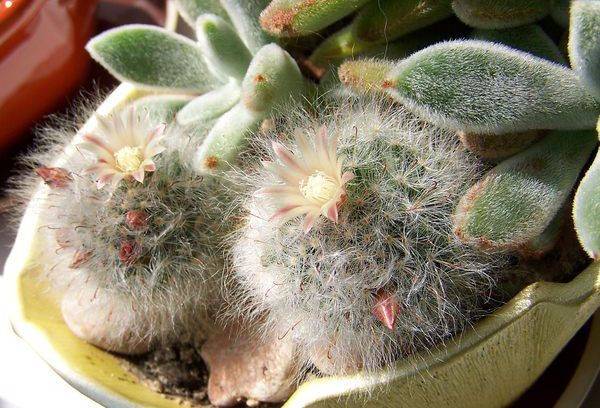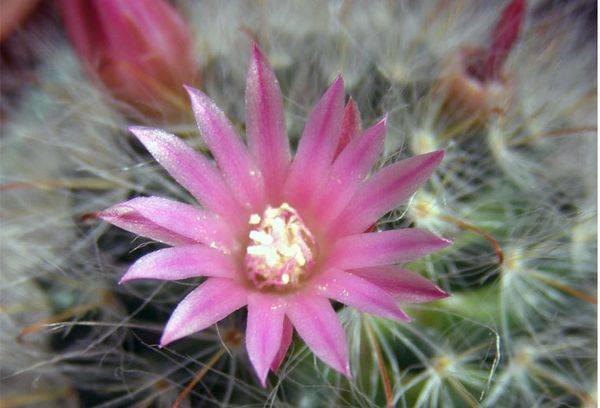How to properly care for mammillaria at home
Content:
One of the largest species of cacti is mammillaria, there are more than 300 varieties. Cacti are unpretentious to growing conditions, so caring for mammillaria is not difficult, but there are still some subtleties.
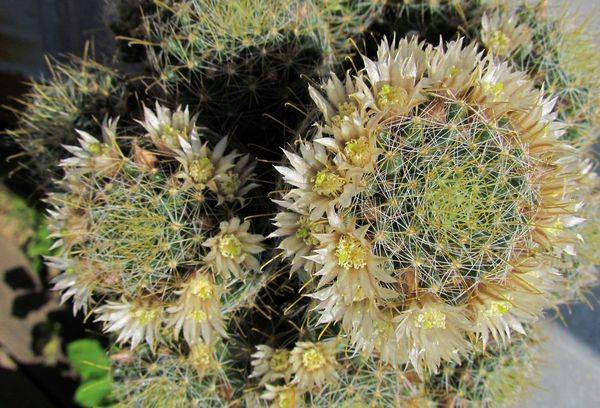
Description
Mammillaria are relatively large cacti with a cylindrical or spherical shape and a dark green color. The main difference from other types of cacti are the papillae located on the stem, from which spines grow. Flowers appear from the axils between them. Varieties of mammillaria have different shapes, colors, structure of flowers and spines. The root system is powerful, although it is located mostly on the soil surface. It is thanks to the thick roots that the cactus easily recovers after a dry period.
Varieties
Almost all varieties of mammillaria have small flowers and are spherical in shape. Some flowers may have only one shade, while others may have two colors at once. A common feature of all varieties is an inflorescence with many stamens inside. The difference from each other is the different color of the spines and stem.
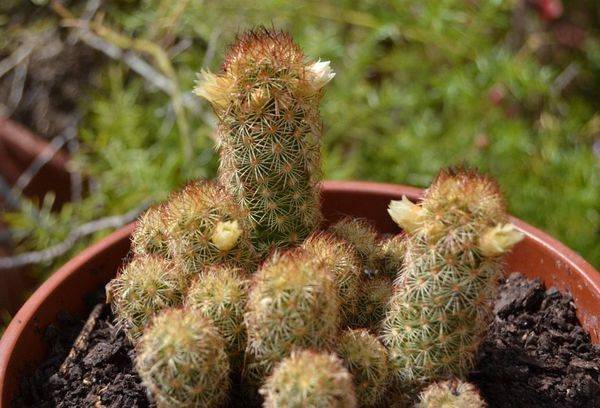
Mammillaria elongata
The most common types of mammillaria are:
- bauma - a round-shaped cactus with white spines that are deformed under the weight of the fruit, usually grows in “flocks”, small flowers, bright yellow;
- wilda — blooms with dull yellow or white flowers, golden-hued spines, hook-shaped, dark green stem, bushy strongly;
- prolifera - oblong in shape, with yellow needle-like or hair-like spines;
- gracilis - propagates very quickly and easily by vegetative means, young specimens are small columns with bunches of spines, an adult plant looks like an inverted pyramid, the flowers are often white, sometimes have a yellowish tint, about 1.5 cm in diameter;
- bokasana (bokasana) - elongated in shape, with white flowers and pink fruits.
Mammillaria Mix does not mean the type of plant, but the name of a set consisting of several different cacti. Sold in flower shops.
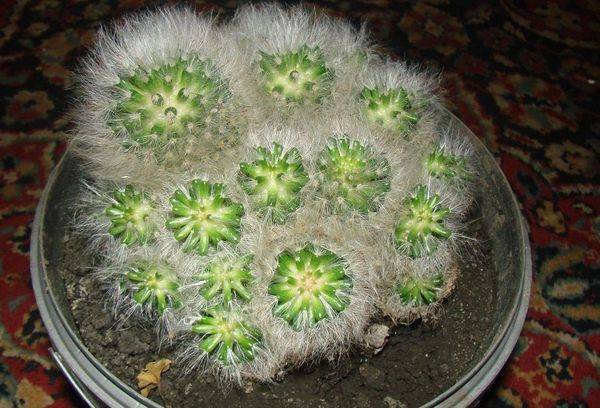
Mammillaria bocassi
How to care - lighting and temperature conditions
Proper care of the cactus at home ensures the excellent appearance of the plant and its flowering.
Despite the fact that cacti are very light-loving, prolonged exposure to direct sunlight is harmful to them. The best option would be a little shade; in the summer months it is better to place the flower on the balcony. The best place to grow mammillaria is the windowsill of a window facing west or east. Here the likelihood of sunburn will be minimal, while the plant will receive enough light and heat.
Favorable temperatures for flowering in the summer months are from +20 to +23° C, while in winter the optimal range will be from +10 to +12°, not higher than +15.If you create such conditions, the cactus will very soon delight you with the appearance of unusual flowers.
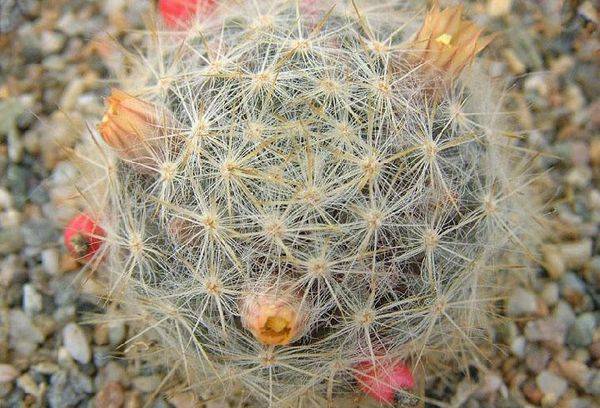
Mammillaria prolifera
Watering
Mammillaria require a minimum amount of moisture in the summer - watering should be done no more than 3-4 times a month. Cacti do not tolerate excess water in the soil very well. In autumn, watering should be reduced to twice a month, in winter - to once a month or stopped altogether.
Advice
The magazine purity-en.htgetrid.com draws attention to the fact that in winter the cactus is dormant. Therefore, it is better not to disturb him during this period; you should not even change the location of the pot. Violation of the dormancy regime may result in the plant not blooming or opening the formed buds and simply dropping them.
Mammillaria is highly resistant to drought, but at the same time loves spraying, especially in the summer when it is hot. Never spray cacti in the sun, as this will cause burns on the plant.
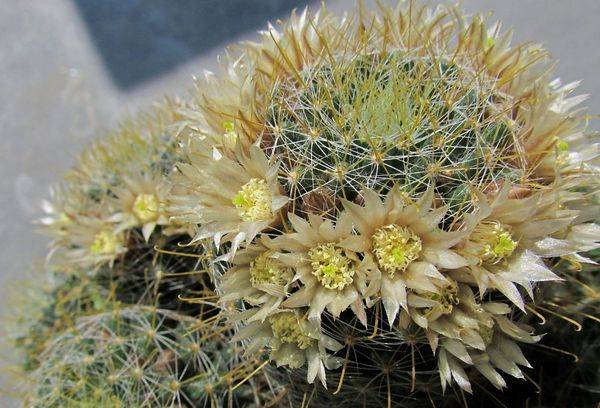
Mammillaria wilda
Soil and fertilizing
Special soil is sold in flower shops for growing cacti. To prepare the mixture yourself, take:
- 1 part of turf land;
- 1 part peat;
- 1 part leaf;
- 0.5 parts of coarse river sand;
- 0.5 parts crushed brick.
Place broken bricks on the bottom of the pot (it acts as drainage), mix the remaining ingredients and pour on top. The resulting soil should allow air and water to pass through well.
Cacti should be fed in spring and summer, no more than once a month, with a weak solution of fertilizer, which is available in any flower shop. How often and in what quantities to feed cacti is usually indicated in the instructions for the fertilizer.Mammillaria, however, develops well even without feeding.
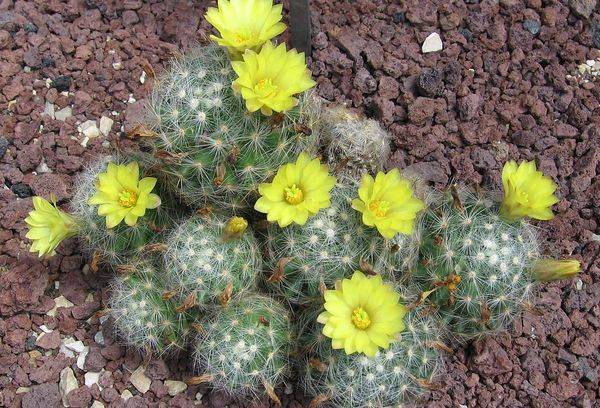
Mammillaria Bouma
Transplantation and propagation
Young cacti should be replanted annually, preferably in early spring, adult specimens - as needed (usually this is done once every 3 years). The pot for growing mammillaria should be shallow but wide, since this type of cacti forms a branched root system that penetrates shallowly into the soil.
Mammillaria reproduces by seeds and lateral shoots. Planting with children (side shoots) is a more effective and convenient way, but experienced gardeners advise preferring seeds if it is necessary to preserve the plant.
Reproduction by children:
- Separate the side shoots from the adult mammillaria closer to the base. This must be done carefully to avoid damaging the shoot.
- Let the babies dry for a few days (leave for a week to allow the cut area to dry).
- Then plant the shoots in small pots filled with soil specially designed for cacti.
- Then sprinkle a little sand on the surface of the soil, water it lightly and place it in a warm place (but not in direct sunlight!).
- When the first spines appear, move the mammillaria to a more illuminated place.
Propagation by seeds:
- Soak the seeds in a solution of potassium permanganate (it should be light pink).
- Place in a container with damp sand and lightly sprinkle the seeds with it.
- Cover the top of the container with glass or plastic wrap, forming a small greenhouse.
- As soon as thorns appear on the grown seedlings, the cacti are ready to be transplanted into permanent pots.
Pests
The two main pests of mammillaria are cactus scale insects and red spider mites.Insecticide spraying is effective as a way to control both pests.
A sign of damage to mammillaria by scale insects is the appearance of very small scales, 1-2 mm in diameter, on the stem. These insects suck out the cell sap, which weakens the cactus. The following insecticides are effective in the fight against scale insects: “Aktara”, “Aktellik”, “Tanrek”, “Fitoverm”, “Vertimek”. Before processing, carefully read the instructions for use of the drug. Folk remedies are also effective: wash the flowerpot, window sill, window with soapy water (the more foam, the better), spray the cactus, rinse the soap suds from the flower after 2-4 hours.
Advice
Before treating the cactus with soapy water, cover the soil with plastic wrap. The product should not come into contact with the soil or roots of the plant.
The danger of mite infection for mammillaria is due to the fact that the plant does not tolerate excess moisture and loves drought, just like an insect. Red spider mites begin to multiply especially actively when air humidity is below 50%.
Signs of red spider mite infestation:
- microscopic cobwebs on the plant in the form of a “dusty” coating;
- yellow dots and spots on the stem, which become brown over time;
- severe damage manifests itself in the form of a clearly visible web entwining the cactus.
As soon as at least one of the signs appears, the cactus immediately needs to be treated with insecticides, alternating between different products. If this is not done, the plant will inevitably die.
An effective method of combating red spider mites is three-time treatment with the Fitoferm insecticide. Once a week, spray the cactus and everything around it. There should be an interval of 7 days between treatments.
It is acceptable to use other insecticides: “Aktofit”, “Aktellik”, “Kleschevit”, “Borneo”, “Sunmite”.
Advice
Do not limit yourself to one treatment, as it will not be enough to kill the juveniles and larvae. It is necessary to spray mammillaria at least 3 times.
There are traditional ways to kill ticks:
- chop 15 g of onion (regular onion), pour in 1 liter of water and let it brew in a closed container for 7 hours;
- Grind 30 g of dandelion roots, add 1 liter of water and leave for 2-3 hours in a warm place;
- Chop 150-200 g of garlic or pass through a press, pour in 1 liter of water, leave in a closed container for 5 days, before use, dilute 5 ml of the solution in 1 liter of water.
It is also necessary to treat with folk remedies many times.
To prevent red spider mites, regularly spray the cactus with a spray bottle.
Useful tips
Recommendations from experienced flower growers will allow you to grow a beautiful flower and ensure its flowering:
- The most dangerous insect pest for mammillaria is the red mite, which loves to settle on spiny varieties of cactus.
- For mammillaria, insufficient watering will be less harmful than excess moisture in the soil.
- A lack of light causes the cactus to become very elongated. This greatly spoils the appearance of the plant.
- The soil for mammillaria should always be loose; it must contain coarse river sand and crushed brick.
Mammillaria look especially elegant in flat flowerpots, when small bushes completely fill the surface. This type of cactus is very decorative, often placed in compositions and looks impressive.
